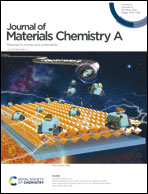High performance self-heated membrane distillation system for energy efficient desalination process†
Abstract
The membrane distillation (MD)-based desalination process is thought to be a promising strategy to address global challenges, such as safe water-energy crisis and environmental pollution. Here, we demonstrate a novel self-heated vacuum (MD) system employing a graphene–PVDF flat sheet membrane Joule heater that enables the combination of the interfacial heating of a feed stream and conventional VMD for energy efficient sea water desalination. In this system, the direct delivery of low voltage DC power to a superhydrophobic graphene–PVDF flat sheet membrane Joule heater was placed in a filtration module, and effectively heats the feed stream directly at the feed/membrane interface. Thus, it eliminates the preheating of feed solution and temperature polarization (TP), along with enhanced permeate flux, which in turn significantly reduces the energy requirement for the desalination process. The graphene–PVDF flat sheet membrane Joule heater was obtained via simple phase inversion technique, and exhibited excellent Joule heating performance, superhydrophobicity, and graphene laminar stacking-induced high porosity. While treating a saline feed without preheating, and with optimum membrane and experimental variables, our self-heated MD system achieved a permeate flux of 23.44 L m−2 h−1 and salt rejection of 99.41%, with the lowest specific heating energy (Qsh) consumption of 0.109 kW h L−1 and the highest gain output ratio (GOR) of 5.72, respectively. This is the greatest performance achieved so far, compared to the performance of solar heating (photothermal) and induction heating-based self-heated MD systems reported previously. The optimum membrane surface temperature (T* = 38 °C) and effective membrane area (71.1%) were assessed using FVM simulation, and were validated by the corresponding experimental results. This energy efficient self-heated vacuum MD system is suitable for high purity water production and effective sea water desalination. Furthermore, by harvesting the electrical energy required for membrane Joule heating from renewable energy (solar energy) and using feed streams with low grade waste heat, we could further increase the economic viability and application potential of the system. The self-heated vacuum MD system demonstrated here constitutes an effective approach for a sustainable, decentralized water desalination technology.



 Please wait while we load your content...
Please wait while we load your content...